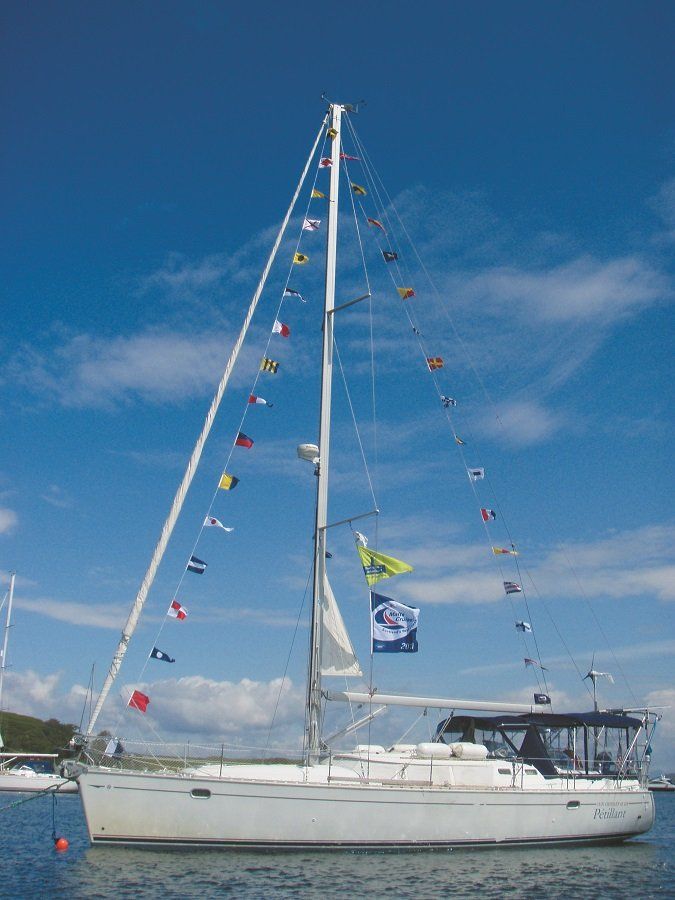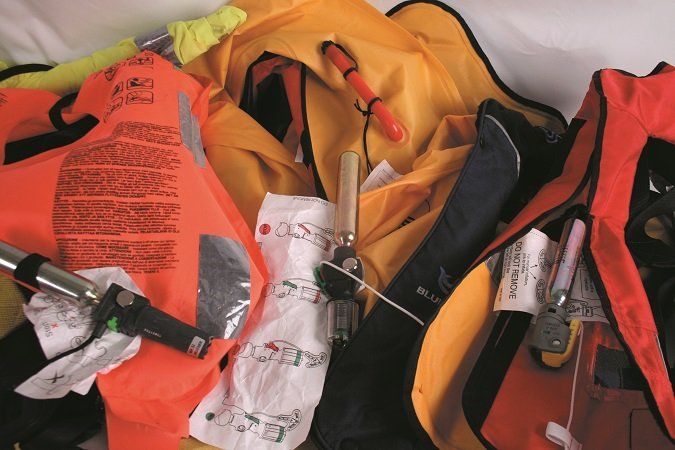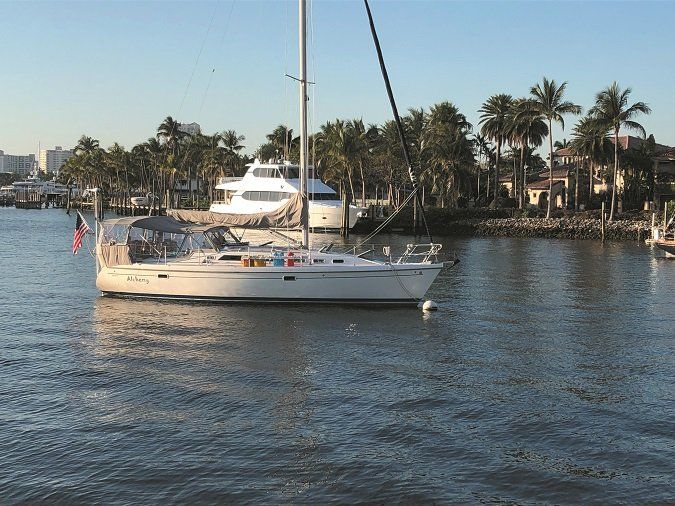Anchoring Etiquette
I really appreciated the article Anchoring in Crowded Harbors (see Practical Sailor, June 2019). The difficult and critical part is always estimating distances, and the guides you gave (two-to-three mast heights, using fractions of a nautical mile, etc.) can be difficult to do accurately in a crowded harbor with the sun setting, with some of that information available only at the helm, and multiple boats moving to anchor. As a bow hunter, I am well acquainted with the benefits of a handheld laser rangefinder. They are small, fairly affordable ($100 – $400), weatherproof, waterproof (check your model for rating, as it varies), and amazingly accurate. Choose the somewhat more expensive LED display models for best low-light performance. These devices give you instant distance down to fractions of a yard (or meter) and are a quick means to accurately understand where multiple boats and the shore sit relative to you. They are a small handheld device that I use from the bow while directing the helmsman. They certainly assist in making the job of calculating swing circles more straightforward.
Eric Uppiano
Olympia, WA
Schatzili, Beneteau Oceanis 38
Stern-tied Boats
With regards to your recent article on anchoring in crowded anchorage. Here in the Pacific Northwest, we often have a mix of boats in the center part of anchorage who swing freely, and boats at the outer edge who are stern tied. Sometimes, the stern tied boats will tie off far enough from shore so they appear be within arc of the swinging boats, should the wind or current change. I can estimate two or three-boat lengths, but beyond that, it becomes less clear to me. I purchased a hunting laser rangefinder with 900-yard range, but it can be hard to read with my glasses on, and impossible without. Is there a reliable way to determine the distance to another boat to confirm whether we are far enough apart?
Robert Sinkus
Via PS Online
Several readers (see Eric Uppianos letter), suggested digital range-finders such as the one you describe (also used for golf and hunting) as the least expensive solution (HD radar will also work, but it at 10 times the price). The only range-finder weve long-term tested is the KVH Datascope, which got mixed reviews and is no longer available.
Wind Generator Research
With regards to your blog post on wind generators (see Inside Practical Sailor blog, Wind Generators, Are They Worth It?), when we bought Antara in 1998, we had a pole-mounted Four Winds generator installed on the quarter. We also had a Hamilton Ferris wind and towed generator (vintage 1990). When used at anchor, the Hamilton Ferris was supported in the fore triangle. At sea, it was used as a towed unit. In the latter mode it produced 6 to 8 amps with a boat speed of 6 to 7 knots. Drag was not noticeable.
When used as a wind turbine, it produced a similar output. With nearly identical swept areas, the two wind turbines produced similar amounts of net power. In the tradewinds they provided nearly all the power we needed, including running a freezer, refrigerator, fluorescent lights and brief HF communication use. Both manufacturers have been courteous and helpful.
As for negatives: the Four Winds unit is slightly noisier, but not objectionable. The Hamilton Ferris turbine was easy to set up. I used a looped line to temporarily secure the blade to the support bar while setting, and pulled it off when the turbine was in place. Getting the mill down in a breeze required more care as one has to reach the end of the support bar (behind the rotating prop) with one hand while managing the halyard with the other. Weve managed this many times without injury. The Hamilton Ferris blade is made from sitka spruce and needs to be treated with care. Also, the windmill components are inconvenient to store.
Philip Glaser
Antara, Passsport 40
Deer Island, ME
Seamanship Takes Priority
Your report on auto-inflating PFDs (see Inside PS, Reframing Our Views on the Auto-inflate PFD) discusses another piece of safety equipment that is counted on to work when required, but which CANNOT be tested until then. This problem applies to life rafts, EPIRBS, PLBs, MOB radios, tethers, fire extinguishers, emergency bilge pumps, EVERYTHING that we count on to work in extremis, and which we are expected to haul around on deck all the time, but which are not used in the way that they are actually designed and intended, until the critical moment.
I also think that we are adding more and more stuff to the list that every sailor is supposed to carry at hand, in order to be safe but it is not making us safer. More attention should be devoted to ensuring that we do not fall overboard by installing more/better permanently installed handholds, and moving sail/rigging controls into the cockpit. Better training is needed in avoiding hazardous conditions-i.e., the time to reef is when you first wonder whether it is time to reef-and practice doing the stuff that needs to be done when trouble arises (try to use your emergency tiller sometime).
The manufacturers of all this stuff need to allow us to observe, or better, participate, when maintenance is done (this is aimed specifically at liferaft repack centers), so that we can see how the equipment actually works. Everyone should use a fire extinguisher, fire a flare, and try out their inflatable lifejacket, in the water, at least once. The purveyors should include several re-arm kits with each lifejacket, so that they can be tested by the owner, and then repacked. When you repack it yourself several times, you develop the skill to do it right, and you should not wonder whether it will work the next time that you need it.
Ralph Caruso
Petillant, Jeanneau 43DS
Palm City, FL

Oral Inflator DIY Fix
Regarding your blog post on auto-inflating PFDs, years ago in the Navy, survival skills in the water included converting trousers into a temporary flotation device in the water by removing them, tying a knot at the bottom of each leg and then filling them with air by grasping each side of the waist band and swinging it quickly forward overhead. Obviously, this needs to be repeated as air is lost. And, though it had definite limitations, it was an experience in resourcefulness. Years later, when on a boat from the United Kingdom, I happened upon a comfortable flotation vest completely dependent upon oral inflation, and I began practicing with it. Together, these experiences have created a relative level of independence when wearing a flotation vest with auto/manual CO2 inflation.
So, in addition to having practiced manual actuation of the CO2 canister, I practice finding by touch alone the oral inflation tube where it is buried beneath a fold of vest fabric. This can be a frustrating experience with cold and wet hands if not done often. But my solution is to connect the oral tube with a short piece of cord to a small stainless steel ring. Of course, one obstacle to this modification being adopted for widespread use is that the lanyard could possibly be mistaken for the pull cord for manual CO2 inflation. If mass produced, it would need to be advertised and labeled correctly-and approved by the U.S. Coast Guard
Steven Gross
Spirit Quest, Tayana 37 PH
Blaine, WA

Unexpected Inflation
Around the time that Practical Sailor first started to raise awareness of these issues, my own auto-inflate PFD inflated while I was on a foredeck in very wet conditions. I was urgently trying to get a genoa down and tied safely during a noreaster, sailing double-handed. When the PFD inflated I suddenly found that I could hardly move my arms-the amount of expansion of the units is impressively large, providing buoyancy but at a cost of severely restricted upper mobility. I couldn’t get my hands together for example-in fact, nowhere close to together. As a result, my wife and I switched to standard, i.e. non-inflating, PFDs. I just couldn’t imagine being so constricted when overboard. The downside of the growth of the market for auto-inflatable PFDs has been that standard alternatives aren’t, in my opinion, as well developed for coastal cruising where one could regularly be 5 to 10 miles off shore. I would like to see Practical Sailor address such alternatives.
Tom Taylor
Alchemy, Catalina 380
Chicago, Illinois

Finicky Auto-inflate PFDs
As a life long sailor and licensed professional engineer who has done product, test, safety, and RAS (reliability, availability, and serviceability) engineering during my career, I had already decided the manually inflatable PFDs with an auto-inflate feature PFDs that I have on my boat would be replaced with inherently buoyant ones as soon as I can find ones I am happy with. My own testing in a pool in San Diego with my new inflatable PFDs was scary-a 50 percent failure rate for the auto-inflate based on four times jumping in the pool with it. One failure was likely due to poor arming on my part (which is a failure of design in that they are so finicky to arm) and the other failure showed no obvious reason why. And the notion of blowing one up manually is laughable in the conditions other than a warm pool in San Diego. Finally, there was the time on a passage north when a spare inflatable PFD went off in the cockpit lazarette that is not included in the above failures. The bottom line is manually inflatable PFDs with an auto-inflate feature do not meet the most basic engineering principle: KISS (Keep It Simple Stupid). The best thing Practical Sailor can do is test all the good inherently buoyant PFDs out there to help those of who are 100-percent done with the inflatable type find suitable, comfortable alternatives.
Joseph DiMatteo
Cabot 36, Triumph
Cruising the Pacific Ocean
Nomenclature Matters
Thanks so much for this valuable reminder regarding auto-inflate PFDs. Its way too easy to misname equipment or features that then, unfortunately, lull the consumer into a false sense of security. Auto pilot on cars is a good example and this has lead to crashes. Auto-inflate on PDFs apparently is another good example. Thanks for bringing this important situation to our attention.
Michael Hedge
via PS Online
Bird Poop Antidote
Regarding your PS Advisor report, Getting Rid of Impossible Boat Stains (see PS September 2017), our go-to cleaner is a mixture of one-part Dawn liquid dishwashing detergent to five parts vinegar, applied undiluted. Not sure where it fits on the scale of these suggestions, but weve found it removes about anything. A stronger commercial product is 30 Second Cleaner, which seems to have a bleach base. We use this stuff sparingly as a last resort.
Ernest Rushing
M/V Quest, Legacy 40
Solomons, MD
Ammonia Vs. Bird Droppings
Before you go out and buy all that expensive boat stuff to clean bird droppings, I would suggest you first try ammonia based home cleaning products. If that doesn’t work, wash it thoroughly with lots of water and try Clorox spray cleaner. Most likely, the bird stain has penetrated the wax on the surface of your deck. Ammonia will strip the wax and bleach will clean the stain.
Fred Brillo
Watkins 29, Second Edition
Ft. Lauderdale, FL










































You should never mix ammonia and bleach products either prior to use (like mixing in a bucket or spray bottle) nor using them together. The two combine to create a lethal gas as it evaporates.